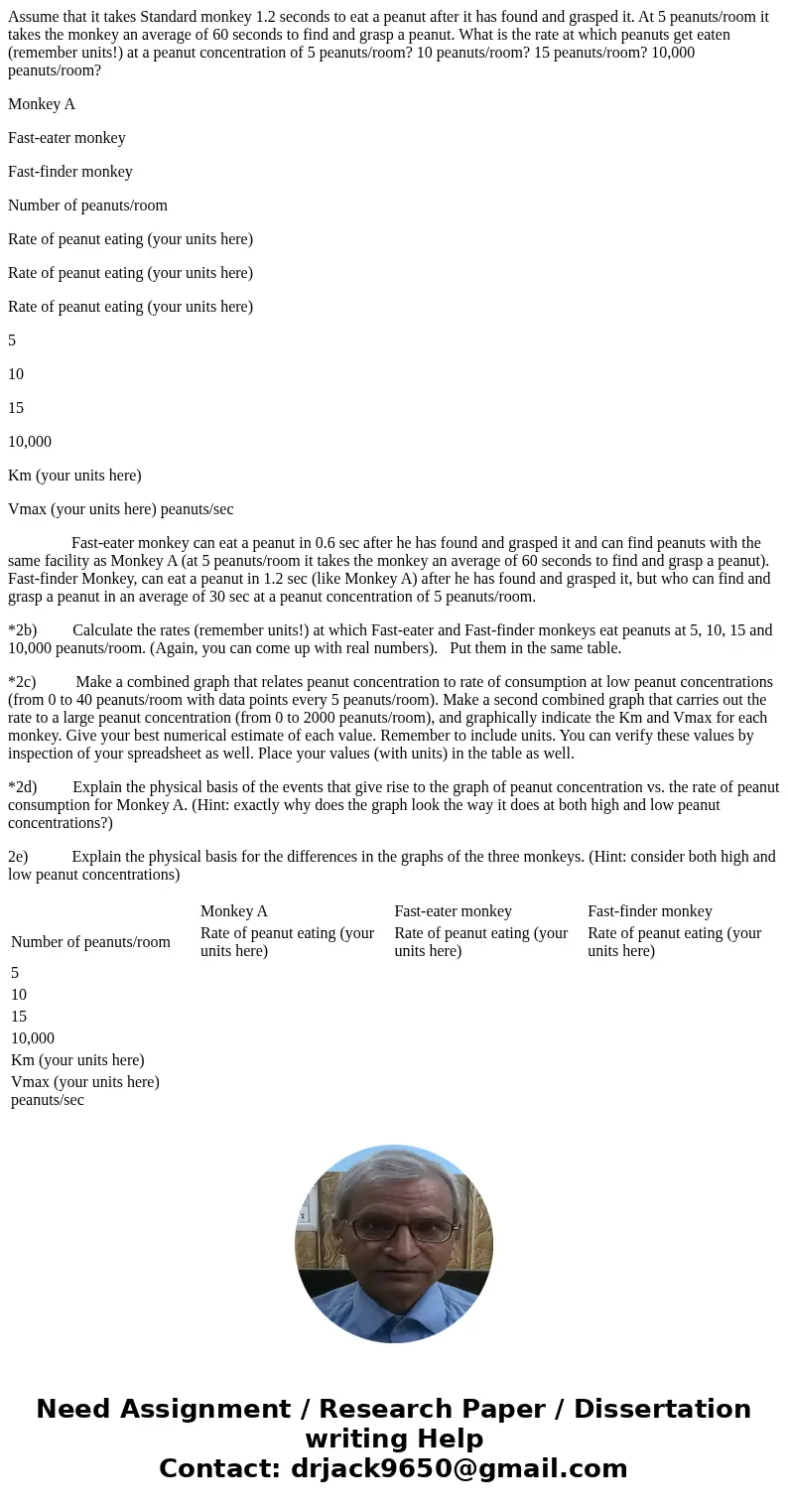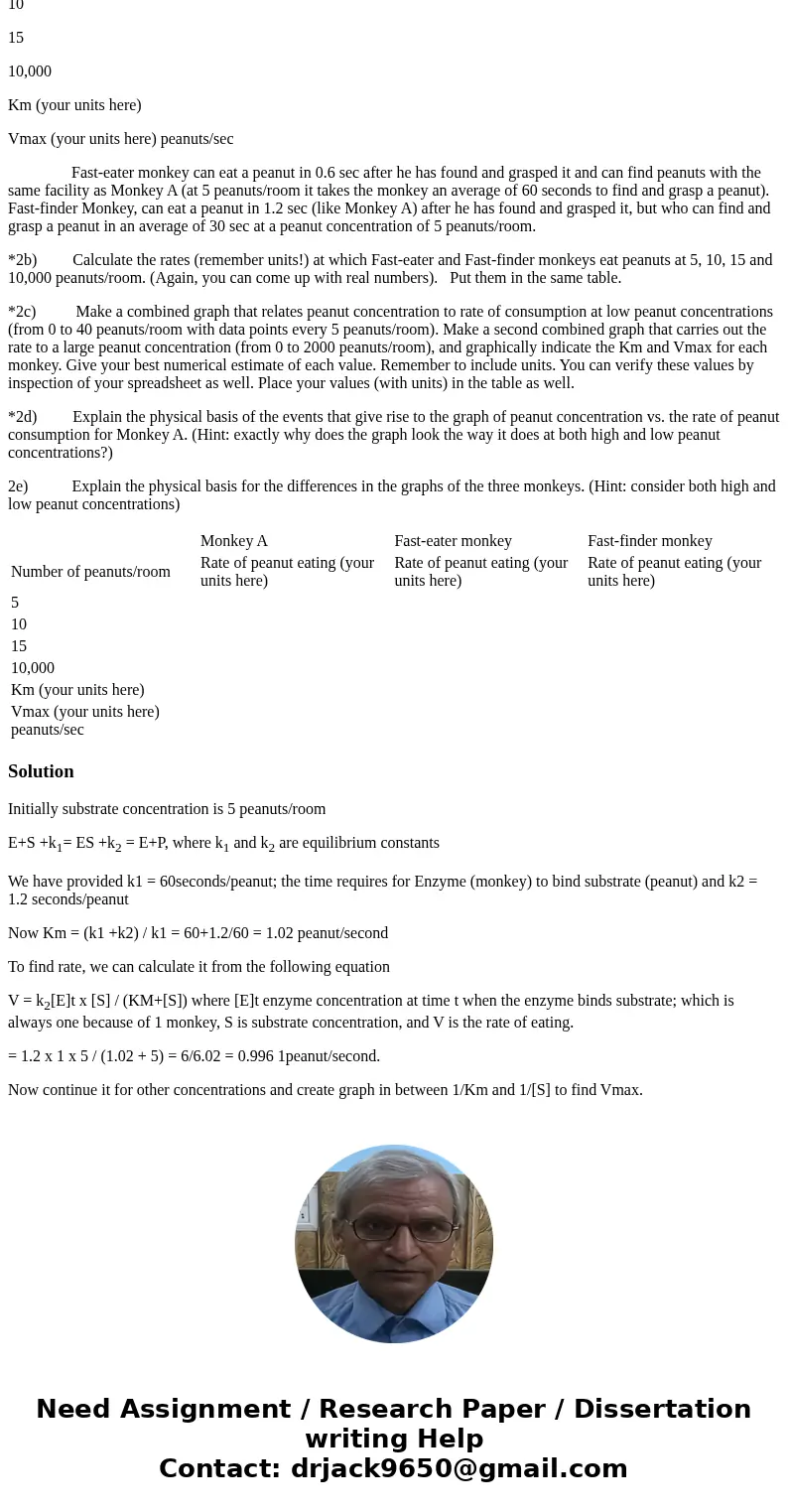Assume that it takes Standard monkey 12 seconds to eat a pea
Assume that it takes Standard monkey 1.2 seconds to eat a peanut after it has found and grasped it. At 5 peanuts/room it takes the monkey an average of 60 seconds to find and grasp a peanut. What is the rate at which peanuts get eaten (remember units!) at a peanut concentration of 5 peanuts/room? 10 peanuts/room? 15 peanuts/room? 10,000 peanuts/room?
Monkey A
Fast-eater monkey
Fast-finder monkey
Number of peanuts/room
Rate of peanut eating (your units here)
Rate of peanut eating (your units here)
Rate of peanut eating (your units here)
5
10
15
10,000
Km (your units here)
Vmax (your units here) peanuts/sec
Fast-eater monkey can eat a peanut in 0.6 sec after he has found and grasped it and can find peanuts with the same facility as Monkey A (at 5 peanuts/room it takes the monkey an average of 60 seconds to find and grasp a peanut). Fast-finder Monkey, can eat a peanut in 1.2 sec (like Monkey A) after he has found and grasped it, but who can find and grasp a peanut in an average of 30 sec at a peanut concentration of 5 peanuts/room.
*2b) Calculate the rates (remember units!) at which Fast-eater and Fast-finder monkeys eat peanuts at 5, 10, 15 and 10,000 peanuts/room. (Again, you can come up with real numbers). Put them in the same table.
*2c) Make a combined graph that relates peanut concentration to rate of consumption at low peanut concentrations (from 0 to 40 peanuts/room with data points every 5 peanuts/room). Make a second combined graph that carries out the rate to a large peanut concentration (from 0 to 2000 peanuts/room), and graphically indicate the Km and Vmax for each monkey. Give your best numerical estimate of each value. Remember to include units. You can verify these values by inspection of your spreadsheet as well. Place your values (with units) in the table as well.
*2d) Explain the physical basis of the events that give rise to the graph of peanut concentration vs. the rate of peanut consumption for Monkey A. (Hint: exactly why does the graph look the way it does at both high and low peanut concentrations?)
2e) Explain the physical basis for the differences in the graphs of the three monkeys. (Hint: consider both high and low peanut concentrations)
| Monkey A | Fast-eater monkey | Fast-finder monkey | |
| Number of peanuts/room | Rate of peanut eating (your units here) | Rate of peanut eating (your units here) | Rate of peanut eating (your units here) |
| 5 | |||
| 10 | |||
| 15 | |||
| 10,000 | |||
| Km (your units here) | |||
| Vmax (your units here) peanuts/sec |
Solution
Initially substrate concentration is 5 peanuts/room
E+S +k1= ES +k2 = E+P, where k1 and k2 are equilibrium constants
We have provided k1 = 60seconds/peanut; the time requires for Enzyme (monkey) to bind substrate (peanut) and k2 = 1.2 seconds/peanut
Now Km = (k1 +k2) / k1 = 60+1.2/60 = 1.02 peanut/second
To find rate, we can calculate it from the following equation
V = k2[E]t x [S] / (KM+[S]) where [E]t enzyme concentration at time t when the enzyme binds substrate; which is always one because of 1 monkey, S is substrate concentration, and V is the rate of eating.
= 1.2 x 1 x 5 / (1.02 + 5) = 6/6.02 = 0.996 1peanut/second.
Now continue it for other concentrations and create graph in between 1/Km and 1/[S] to find Vmax.


 Homework Sourse
Homework Sourse